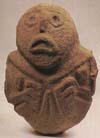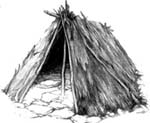{tab=highlights}
Lepenski Vir museum is located 15 kilometres away from Donji Milanovac, on the road that goes via Golubac and further on to Pozarevac and Belgrade (when you reach the road sign for the museum, just go couple hundreds of meters down a steep road). This is the only road that leads to Lepenski Vir, and you can get there either using your own car or a local bus from Donji Milanovac. 
Lepenski Vir archeological find is one of the most significant discoveries in the world, but unfortunately, due to the limited resources, it can’t grow to its full potential as a tourist hotspot. Part of this complex is an ethno park with characteristic houses from the last century, that you’ll see as soon as you descend from the main road. About 400 meters away, going down the path through this nice park, you’ll reach the museum building, exhibiting maps, photos and scripts from the archeological excavations in this area, as well as the famous Neolithic stone statues (copies, because the originals are kept in the National Museum in Belgrade).
Just next to the building there’s a site with the basis of prehistoric structures. The whole sight has been moved from its original spot around 30 meters uphill, since the Danube water level rose for 12 meters after the hydroelectric power plant and the accumulation lake were constructed. Although the finds were safely relocated and preserved, it was impossible to continue with the excavations so a lot of precious artifacts from the last 20.000 years of human civilisation were left at the bottom of the Danube.
The settlement developed in four stages. The first is dated from 6.500 years BC, when the first tribes settled on this plateau by the Danube river. Thanks to its good climate, location and the natural rich of the area, this first communities of hunters-gatherers established the first habitats. The next two stages, altogether with the first one, cover the seven layers of excavation and belong to the period until the year 5.300 BC, when the fourth stage took place, encompassing two layers. In this stage, that lasted until the year 4.500 BC, people started to deal in agriculture, cattle breeding and upgrading the settlement. This was the time of the so called Neolithic revolution, when people, apart from hunting and fishing, started taming the first animals and cultivating the land. This is when they started making the first dishes, tools and other artifacts they needed. Different beliefs emerged, such as the cult of Mother Earth. Thus the specific way of burying the dead, away from the settlement in embryonal position, which falls in line with the belief of oldest agricultural societies that everything comes from Mother Earth and goes back to it. The statues found at the excavation site are of an extreme significance, and they used to represent some kind of deities of the inhabitants of Lepenski Vir, some kind of stone idols. Statuettes were made of round pebbles in shape of fish-like creatures (thus the theory that deities had something to do with the river) and were often decorated with some kind of a pattern.  Remains of the settlement are especially interesting. To get the better use for the plateau next to the Danube river, the inhabitants of Lepenski Vir had to plan its construction. In all the phases there is a central structure, in front of which there’s an empty space turned towards the Danube, that probably functioned as a main square. All the other objects are regularly placed around, framing the square in shape of a horseshoe and forming some kind of primitive streets around 1 meter wide, leading either to the square or to the Danube. Lepenski Vir is, for this reason, today considered as the oldest urban settlement in Europe. The basis of all the structures are trapezoid and it is believed that above them there used to be some kind of a primitive wooden construction resembling a tent. In one part of the foundation there is an embedded hearth.
Remains of the settlement are especially interesting. To get the better use for the plateau next to the Danube river, the inhabitants of Lepenski Vir had to plan its construction. In all the phases there is a central structure, in front of which there’s an empty space turned towards the Danube, that probably functioned as a main square. All the other objects are regularly placed around, framing the square in shape of a horseshoe and forming some kind of primitive streets around 1 meter wide, leading either to the square or to the Danube. Lepenski Vir is, for this reason, today considered as the oldest urban settlement in Europe. The basis of all the structures are trapezoid and it is believed that above them there used to be some kind of a primitive wooden construction resembling a tent. In one part of the foundation there is an embedded hearth.
What fascinates the most is that the shape and the material used for the construction of the settlement influenced the heating and the functionality of the structures. The heat from the embedded hearth was regularly spreading around the house floor, and the shape ensured more economic heating, meaning that these structures had some kind of a floor heating.
{/tabs}

